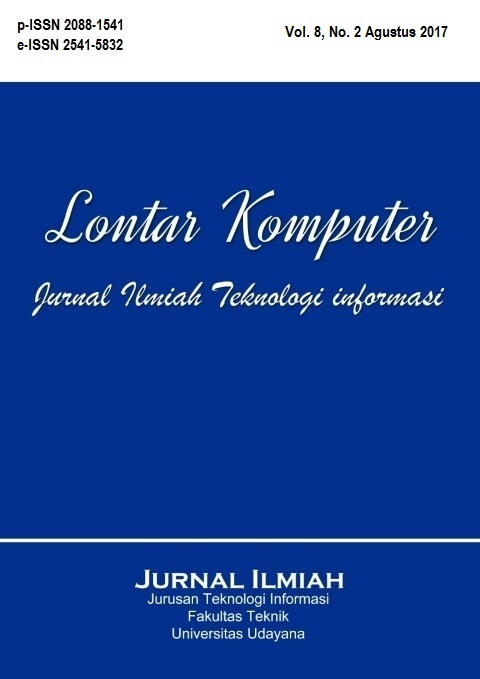Sistem Informasi Monitoring Perkembangan Anak di Sekolah Taman Kanak – kanak Berbasis Cloud
Abstract
Education is a means to advance human resources. Achieving educational progress requires a tool for managing data such as curriculum data, students and grades. This tool can be used to control student activities in school so that the results can be delivered immediately and the monitoring process can run effectively because of communication between the school and parents. Child Development Monitoring Information System at Cloud-Based Kindergarten School is a Web-based Software As A Services (SaaS) service. This information system created by using cloud technology provides facilities to perform the management of various academic data such as student data, values and so forth. A cloud-based academic information system service that can be relied on to operate online without servers and installations for every system in school. The use of cloud technology in making this application is expected to further simplify the process of academic data management and school data that is generally done conventionally. The results of research conducted by spreading the questionnaire using Likert scale calculations show more than 50% of users agree with the statement already made.
Downloads
References
[2] F. S. Prambudi, “Sistem Informasi Monitoring Siswa Bermasalah Berbasis Web dan SMS Gateway (Studi Kasus: SMA Negeri 2 Trenggalek),” Jurnal JSIKA, vol. 1, 2012.
[3] P. W. Wirawan, “Integrasi Sistem Informasi Akademik dengan Sistem Monitoring Prestasi Akademik untuk Pengelolaan Sekolah,” J. Ekon. Manaj. Akunt., vol. 24, 2016.
[4] E. D. Seeman and M. O’Hara, “Customer relationship management in higher education,” Campus-Wide Inf. Syst., vol. 23, no. 1, pp. 24–34, 2006.
[5] A. Novianti, A. Fauzijah, R. Masalah, and B. Masalah, “Sistem Informasi Sekolah Dasar Berbasis Sms,” Sist. Inf. Sekol. Dasar Berbas. Sms, vol. 2009, no. Snati, 2009.
[6] A. Setiadi, “Sistem Informasi Pengumuman Program Studi Di Perguruan Tinggi X,” Lontar Komputer: Jurnal Ilmiah Teknologi Informasi, vol. 8, no. pp.879-889, 2017.
[7] M. Arfan, “Model Implementasi Centralized Authentication Service pada Sistem Software As A Service,” Jnteti, vol. 3, no. 1, 2014.
[8] C. Hewitt, “ORGs for scalable, robust, privacy-friendly client cloud computing,” IEEE Internet Comput., vol. 12, no. 5, pp. 96–99, 2008.
[9] R. A. Firmansyah, “Desain Integrasi Learning Content Management System Pada Cloud-Base Sistem Informasi Sekolah ,” Stmik Stikom, pp. 7–12, 2013.
[10] I. D. Made, A. Baskara, and I. K. B. Sandika, “Sistem Informasi Manajemen Sebagai Alat Pengelolaan Penelitian Dosen,” Lontar Komput., vol. 7, no. 1, pp. 726–735, 2016.
[11] A. Kadir, Dasar Perancangan & Implementasi Database Relasional. Yogyakarta : Penerbit Andi Offset, 2008.
[12] M. Yazdi, “E-Learning Sebagai Media Pembelajaran Interaktif Berbasis Teknologi Informasi,” Jurnal Ilmiah Foristek, vol. 2, no. 1, pp. 143–152, 2012.
[13] A. Budiyanto, “Pengantar Cloud Computing,” Cloud Indones. Jakarta, pp. 1–10, 2012.
[14] Muhammad Ali, “Pengembangan Media pembelajaran Interaktif Mata Kuliah Medan Elektromagnetik,” Jurnal Edukasi@ Elektro, vol. 5, no. 1, pp. 11–18, 2009.
The Authors submitting a manuscript do so on the understanding that if accepted for publication, the copyright of the article shall be assigned to Jurnal Lontar Komputer as the publisher of the journal. Copyright encompasses exclusive rights to reproduce and deliver the article in all forms and media, as well as translations. The reproduction of any part of this journal (printed or online) will be allowed only with written permission from Jurnal Lontar Komputer. The Editorial Board of Jurnal Lontar Komputer makes every effort to ensure that no wrong or misleading data, opinions, or statements be published in the journal.
 This work is licensed under a Creative Commons Attribution 4.0 International License.
This work is licensed under a Creative Commons Attribution 4.0 International License.























